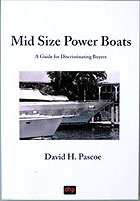How to Decide if
Buying an Older Boat is Right for You.
There are Great Values in Used Boats, But the Cost is More Than Just the Price
by David Pascoe
When we were young, we just loved the idea of buying a new car. But by the time we've owned three or four of them - often without paying off the balance of last one before buying the next - eventually we discover what a tremendous waste of our financial resources this is. When it comes to boats the situation's not much different, except now we're talking about serious money.
New vs. Old
Most people want to buy a brand new boat and rationalize it by saying, "Well, I don't want to fool around with all the breakdowns and problems involved with a used boat. I want a new one that's free of all that hassle."
You know the arguement, we've all used it. As the late John D. Mac Donald might say, anyone with a deep saltwater tan would crack a smile over that one. Boaters who've had the experience of fitting out a sizable new yacht know that they're hardly trouble free.
And the cost? Financing a new boat purchase over ten, twelve or fifteen years is hardly good economics when the average period of ownership is probably less than four years. What could give you more of a sinking feeling than to have to write a check to the bank when it comes time to sell because you owe more than its worth? That can really take the pleasure out of boating.
That argument aside, the point is that more and more yachtsmen are discovering that there really are great values to be had in used boats, particularly older ones that have reached the point where the shine is gone, the style is no longer the latest, the engines are blowing smoke and the interior is a bit more than just shopworn.
The one great advantage of considering purchasing and refurbishing an older yacht is the tremendous differential in the cost of new versus used. A boat that sells for $800K new might have a resale value of $250-300K twelve years later. That's a whopping difference of a half-million dollars, so it doesn't take much imagination to see what could be done in the way of refurbishment with even half that amount.
This article will explore the financial considerations plus the practical reality of a refurbishing project, to help you decide whether purchasing an older yacht is right for you.
Investment of Your Own Time
Of course refurbishing an older yacht is not only costly, but involves a substantial investment of your own time. Most of that time is spent making decisions, drawing up plans, finding the right people to do the work, supervision and financial controls.
Right off the bat, you can see that this is no small task. The right way to answer the question of whether its worth your valuable time to get involved in something like this is to look at the cost factors.
If purchase price plus cost of refurbishment is substantially less than new cost, then compare this difference against the value of your own time. A major project like this will interfere with your earnings. Whether you're on salary or self-employed, rest assured that you will lose significant work time because, even if only by phone, you'll be putting in daytime hours on the project. If it looks good on paper, and you like doing this sort of thing, then maybe the project is right for you.
Budget for Refurbishment
If it is, the next important consideration is how much to budget for refurbishment. The biggest mistake that most used boat buyers make is to grossly underestimate the cost of putting things in order, even if they don't plan to do all that much.
A common example is someone who buys a fifteen year old 46 foot sport fisherman for $175,000 and then thinks it only needs another $15,000 to get it in shape. This, for a boat with a replacement cost of $750K. Obviously, $15K is a drop in the bucket, and if that's all he can afford, he really can't afford the boat anyway.
First of all, start with the realization that when you spend a lot of money for a used boat, you're not going to be all that happy with an expensive, but well-worn cast off. You'll not only want to bring back some of the shine, but assure some reliability too. You want to feel good about your purchase, and to do that you have to spend more than just the purchase price. In other words, the price is only part of the cost.
When evaluating a budget for a used boat, think of price in terms of what a new boat costs, for this puts the matter of cost in its proper perspective. Since the choice is between new and used, the difference in cost must be a factor in assessing what it will cost to own a used boat. There's a reason why that 15 year old boat is selling for $175K and not $750K: its called wear and tear. It's got $575,000 worth of lost value, a sizable part of which would be required to bring it back to tiptop shape.
A very good rule of thumb for estimating refurbishing costs is to allow at least 50% of the purchase price for a boat in average condition and 100% for one in poor condition. These numbers assume that most the expenses go to engine, machinery, various systems and interiors.
However, more extensive refits require even more (such as repainting and major interior renovations or new equipment additions) and are not beyond the bounds of being a reasonable investment. Ultimately, it all depends on the relationship between replacement cost and purchase price, and how far you want to go toward making the yacht look and function like new.
Don't make the mistake of thinking of cost in terms of what resale value will be years later. You don't recover your costs with a new boat, and you won't recover them with a refurbished used one either. While you'll probably get more than you paid, it won't be all that much more. What you spend is not an investment, but for your own pleasure.
From experience we know that even late model diesel motor boats require a certain percentage of sale price to repair defects, replace canvas, upholstery, carpet, upgrade electronics and all the other things that new owners usually attend to.
This depends on size and value, but for a six year old 40 footer would typically be 8-10% of price. After six years, that amount rises steadily, mainly because of increasing deferred maintenance, meaning wear and tear that stays worn and torn.
By the time the vessel is 12 years old, deferred maintenance reaches the point where the entire boat may need refurbishing, and we're no longer talking about 50% but 100% of sale price or more. Does this kind of money make good sense? Again, think about how much more a new, or newer, boat will cost.
That's the reason why buying an older vessel and only allotting a 10% repair budget is a mistake. In that case, you own a boat that's still on the downward slide and your deferred maintenance and costs only continue to escalate as things break down and deteriorate at an ever-increasing rate.
And if you can't afford it, this is not an enviable position to be in. It can really take the pleasure out of boating. If you're looking at a larger boat than you would ordinarily consider, just because it is older and the price is lower, you need to re-aim your sights on something smaller.
Boatyard vs. Small Contractors
Another important consideration is that extensive refurbishment at typical boatyard prices is cost prohibitive. But in most of the major yachting centers there are many small contractors who are capable of doing very good work at reasonable prices, and this is the way the vast majority of major projects get accomplished.
However, there is a tradeoff for this savings and it comes at the expense of your personal time required to find, negotiate and supervise a variety of contractors. Most boat owners solve this problem by first finding a reliable project manager who can take care of most of these details. While there's no shortage of such people, great care must be taken to ensure that this person is both qualified and reliable.
Planning & Cost Control
Also consider the time frame. Every such project usually takes twice as long as anticipated. Medium size jobs take about six months while major refurbishments run close to a year, with some exceptions that I'll explain.
As with everything in life, the better the planning, the smoother things go. It is extremely important that even medium size jobs be well-planned. Projects can turn into disasters due to a lack of planning. Every hour spent on planning can save dozens of hours of wasted effort.
Before even considering the project, first seek out the most experienced project manager you can find. Get professional help and pay him to size the job up for you and give you a rough estimate of overall cost. This should be done before you complete the purchase. Once you're comfortable with the rough numbers, then you can complete the sale and move on to detailed plans and estimates.
Anyone who has done several major refits can fairly easily rough out the overall cost. But its not until you actually own the vessel and have spent sufficient time on it (possibly tearing things apart), that you really get a handle on what needs to be done. And, of course, there is always more to be done than you anticipated. The tendency is always to try do more, to expand the project, and it is here that you're planning and cost controls will really pay off.
The most successful jobs are done with a plan and a budget, for the budget is what will keep you from straying from the plan and opening Pandora's box. Every boat has one and it helps to know where it is and how to keep the lid on tight. Unless money is no object, toe the line between what needs to be done versus impulse and vanity decisions. Stick with the plan and save the options for later - if you're still within budget.
Many refits got off-track because the owner became distracted with luxurious interiors and fancy gizmos while neglecting a pair of worn out engines or other important systems. When an engine goes "bang" the owner comes up short because he spent all his money elsewhere. For this reason it is imperative to schedule all work by priority. Restoring major systems to reliability must always come first, before considering cosmetics and amenities.
Fundamentals, not Esthetics
Finally, a word about how well the overall job is accomplished. As a surveyor, I see numerous refurbishing projects, the majority of which lavish money on esthetics but ignore fundamentals. But surveyors are not impressed with Italian leather, Travertine marble and designer furnishings.
Our interest is structures and basic systems. Know that when it comes time to sell, your project will be largely judged by fundamentals, not esthetics. If you shortcut the quality of basic systems, it will adversely affect the resale value.
A recent example will give you an idea of just how important the fundamentals are. A boat owner invested nearly $300K in the refit of a 20 year old sport fisherman. Virtually all of it went to modifications, interior amenities and new equipment, while completely ignoring problems with the hull and run down machinery and systems. It needed an infusion of another $150K to deal with these problems. The end result was that the boat was worth little more than he originally paid for it. All of his effort and investment was akin to gilding a wilted lily.
Surveyors and knowledgable buyers will be more impressed with good quality and attention to detail on basic systems such as machinery, plumbing and wiring than designer carpet and sculptured glass. It tells the observer the seller knew what he was doing and put his money where it counted most, on systems that are sound and reliable.
A last word about budgeting: if your budget it tight, allow 10-15% of your total budget for the unexpected. No matter how well you plan, there will always be unexpected problems cropping up. If no problems arise, well then, you can buy that fancy new gizmo or put in that sculpture glass panel of a marlin or whatever.
Approached with knowledge and understanding, projects like this can be fun and rewarding. Projects that are fully estimated, adequately funded, and with sufficient time allotted, usually move ahead smoothly and without major hassles.
Get good advice, hire the right people, plan carefully and the end result will be a project customized to your own liking and one which you can be proud of. You'll end up with a nearly new boat for far less than the cost of a new one, and one which will be a hot item on the resale market.
Additional
Reading:
MARLIN
MONROE : Bertram 42 Convertible
Making
an Old Boat New
Fundamentals
of Restoration Projects: Part I
Fundamentals
of Restoration Projects: Part II


















David Pascoe is a second generation marine surveyor in his family who began his surveying career at age 16 as an apprentice in 1965 as the era of wooden boats was drawing to a close.
Certified by the National Association of Marine Surveyors in 1972, he has conducted over 5,000 pre purchase surveys in addition to having conducted hundreds of boating accident investigations, including fires, sinkings, hull failures and machinery failure analysis.
Over forty years of knowledge and experience are brought to bear in following books. David Pascoe is the author of:
In addition to readers in the United States, boaters and boat industry professionals worldwide from nearly 80 countries have purchased David Pascoe's books, since introduction of his first book in 2001.
In 2012, David Pascoe has retired from marine surveying business at age 65.
On November 23rd, 2018, David Pascoe has passed away at age 71.
Biography - Long version